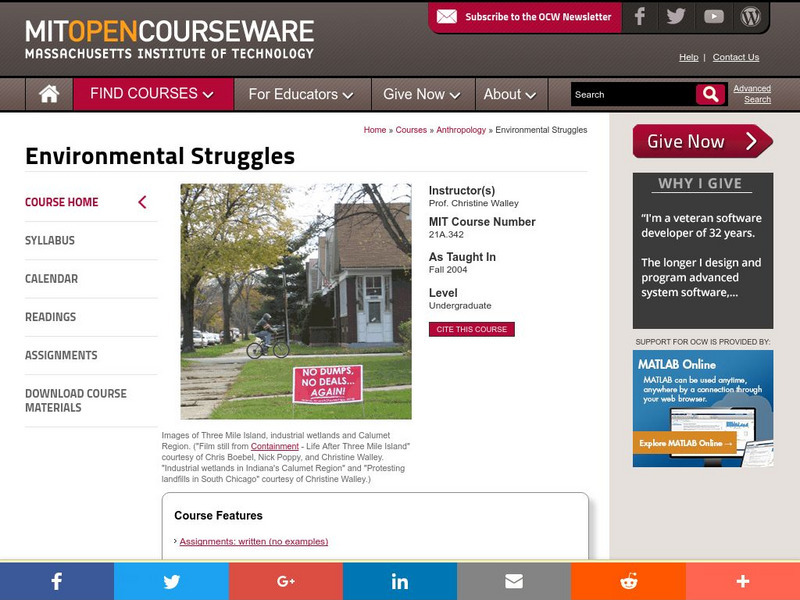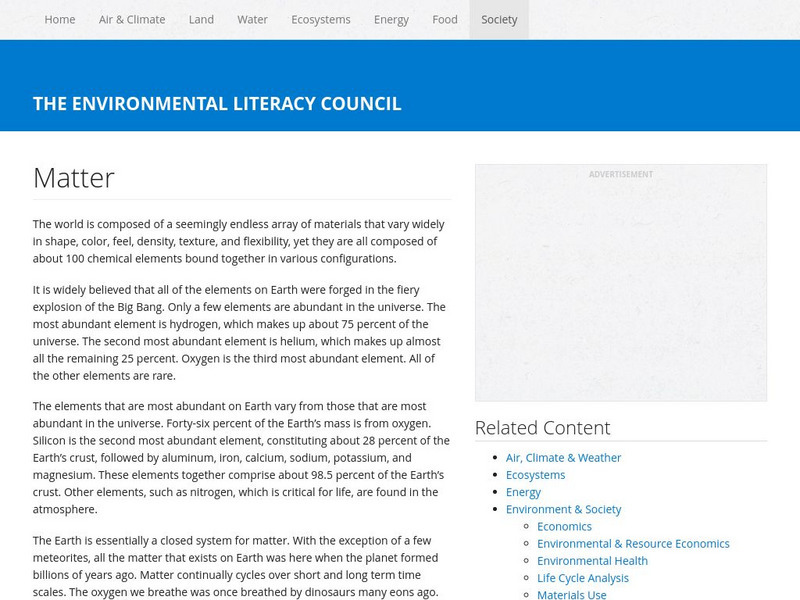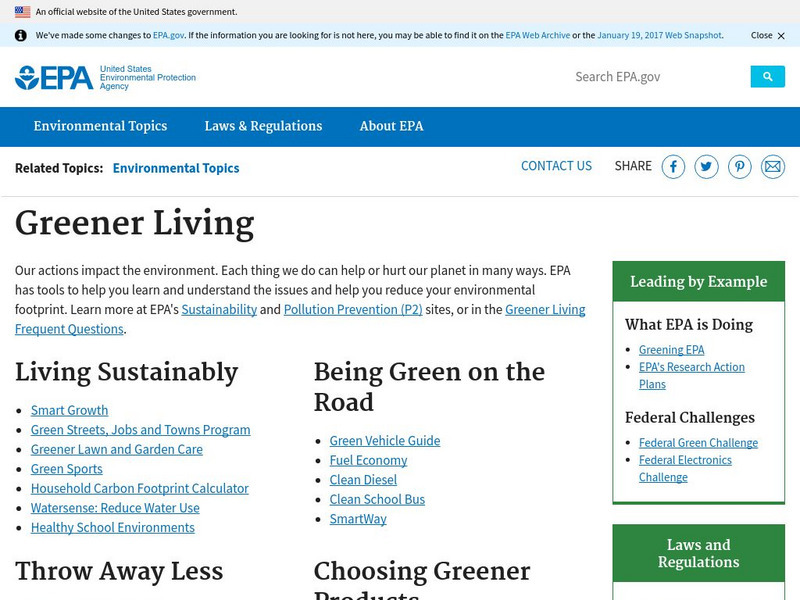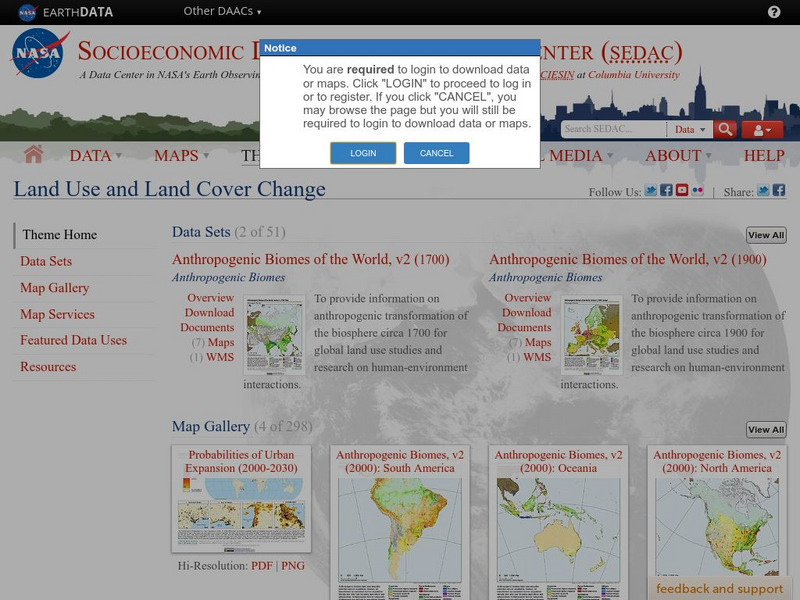Georgia Department of Education
Ga Virtual Learning: Ap Environmental Science: Course Introduction
An introduction to Environmental Science, an interdisciplinary field of study that integrates the biological and physical sciences in an effort to understand environmental systems, and the solutions to both man-made and natural...
Georgia Department of Education
Ga Virtual Learning: Introduction to Environmental Science
With this collection of video tutorials and student assignments, students learn about the interdisciplinary science that focuses primarily on solving environmental problems.
National Institutes of Health
U.s. Dept of Health and Human Services: Cancer and the Environment [Pdf]
Document provides information on the causes and nature of cancer and particularly the substances in the environment that are known to cause or may cause cancer in humans such as tobacco, ultraviolet radiation, pesticides, and metals.
PBS
Pbs Learning Media: Primary Source: Environmental Preservation Progressive Era
This collection uses primary sources to environmental preservation in the Progressive Era.
The World Bank
World Bank: Data Catalog
This resource provides statistical data on numerous categories for nearly every country in the world. A great tool for a comparative analysis. Human, natural, and capital resources are all included.
Library of Congress
Loc: Natural Disasters: Nature's Fury
People have always tried to understand the natural world in which they live. In early times, they created myths to explain their experiences with fire, flood and other violent forces. Over the centuries, new scientific discoveries added...
US Environmental Protection Agency
Epa: Natural Disasters: Drought
A look at some real-world issues as well as the scientific research and technology used to support the EPA's mission to protect human health and safeguard the natural environment.
US Environmental Protection Agency
Epa: Natural Disasters: Hurricanes
See some real-world issues as well as the scientific research and technology used to support the EPA's mission to protect human health and safeguard the natural environment.
US Environmental Protection Agency
Epa: Natural Disasters: Wildfires
Find out about real-world issues as well as the scientific research and technology used to support the EPA's mission to protect human health and safeguard the natural environment.
US Environmental Protection Agency
Epa: Natural Disasters: Tsunamis
This site provides real-world issues as well as the scientific research and technology used to support the EPA's mission to protect human health and safeguard the natural environment.
Other
Rourke Publishing: Natural or Man Made [Pdf]
A science text for young children that looks at which materials are made by humans and which are found in the natural world. Includes lots of photographs, ideas for discussion, a glossary, and comprehension questions.
Smithsonian Institution
Environmental Research Center: Forces of Change: Listening to the Prairie
A large collection of lessons on prairie agriculture for Pre-K to Grade 12, organized into grade level groups. They cover such topics as foods that come from agriculture, animal farming, soils, and environmental issues. These lessons on...
Massachusetts Institute of Technology
Mit: Open Course Ware: Environmental Struggles
Identifying the relationship between humans and the environment can be emphasized with these resources.
Science Education Resource Center at Carleton College
Serc: Disaster Dynamics
The goal of the Disaster Dynamics project is to create games that teach players about the interaction between natural hazards and human decisions.
The Environmental Literacy Council
Environmental Literacy Council: Matter
Learn about the considerable variety of materials on Earth, and the basic properties which set them apart. Read how all matter on Earth comes into play when it comes to environmental issues.
E-learning for Kids
E Learning for Kids: Science: Denmark: What Are Natural Resources and Why Are They Important?
Learn about natural resources, both renewable and nonrenewable, and the impact humans have on the natural world.
Other
Maryland Department of Natural Resources: Chesapeake Bay
This site, from the Maryland Department of Natural Resources, explains the effects that humans have had on Chesapeake Bay. It explores the changes in the bay that have occurred over time.
TeachEngineering
Teach Engineering: Environment
Through 10 lessons and more than 20 hands-on activities, students are introduced to the concept of an environment and the many interactions within it. As they learn about natural and human-made environments, as well as renewable and...
US Environmental Protection Agency
Epa: Learn the Issues: Green Living
This site provides real-world issues as well as the scientific research and technology used to support the EPA's mission to protect human health and safeguard the natural environment.
US Environmental Protection Agency
Epa: Learn the Issues: Flooding
This site provides real-world issues as well as the scientific research and technology used to support the EPA's mission to protect human health and safeguard the natural environment.
US Environmental Protection Agency
Epa: Learn the Issues: Tornados
Find out about some real-world issues as well as the scientific research and technology used to support the EPA's mission to protect human health and safeguard the natural environment.
PBS
Pbs: Nature: Born to Be Wild, Polar Bears
Research the diet, habitat and behavior of polar bears, and compare and contrast the issues surrounding polar bears in their environment with those of bears in the U.S. Rocky Mountains. Rewrite a human/bear encounter from the bear's...
University of Texas at Austin
University of Texas: Human Environmental Interactions [Pdf]
Inspired by Hemispheres' 2004 Teachers' Summer Institute, People and Place: Human-Geographic Relations, this curriculum unit was designed to address human adaptation to and modification of the environment. How have humans adjusted to...
Columbia University
Nasa: Sedac: Land Use and Land Cover Change
[Free Registration/Login Required] A collection of twenty-six data sets from SEDAC (Socioeconomic Data and Applications Center) that examine land use and how human activities have impacted on land cover. They look at agriculture, loss of...


![U.s. Dept of Health and Human Services: Cancer and the Environment [Pdf] Website U.s. Dept of Health and Human Services: Cancer and the Environment [Pdf] Website](https://content.lessonplanet.com/knovation/original/224070-96b08e2e287ce61f7938dd5f317a86cb.jpg?1661495292)

















